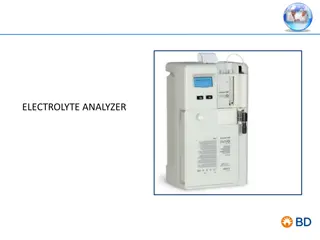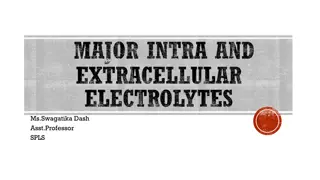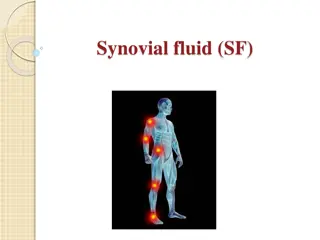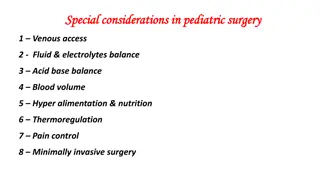Understanding Fluid and Electrolyte Management in Surgical Patients
This article delves into the intricacies of fluid and electrolyte management in surgical patients, covering topics such as total body water distribution, fluid compartments, electrolyte composition, body fluid changes, and disturbances in volume, concentration, and composition. It explores the fluid dynamics within the body, emphasizing the importance of maintaining a delicate balance to support optimal surgical outcomes.
Download Presentation

Please find below an Image/Link to download the presentation.
The content on the website is provided AS IS for your information and personal use only. It may not be sold, licensed, or shared on other websites without obtaining consent from the author. Download presentation by click this link. If you encounter any issues during the download, it is possible that the publisher has removed the file from their server.
E N D
Presentation Transcript
FLUID AND ELECTROLYTE MANAGEMENT OF THE SURGICAL PATIENT GRACE C. FIRMALINO, MD, FPCS July 13, 2020
Total Body Water (TBW) 50 60% of total body weight Relatively constant Reflection of body fat Lean tissues (muscle, solid organs) > fat, bone Average young male 60% > Average young female 50% Estimates adjusted by 10 to 20% downward for obese and upward for malnourished Highest in newborns 80%
FLUID COMPARTMENTS TBW divided into three compartments Plasma Interstitial Intracellular Plasma (5%) and interstitial fluid (15%) make up the extracellular fluid compartment 1/3 of TBW or around 20% of total body weight Intracellular fluid 2/3 TBW or around 40% of total body weight
FLUID COMPARTMENTS ECF sodium (principal cation) and chloride and bicarbonate (principal anions) ICF potassium, magnesium (cations); phosphate and sulfate (anions) and proteins
BODY FLUID CHANGES Healthy person consumes 2000ml of water per day 75% oral intake Daily losses Urine 800 to 1200 ml Stool 250 ml Insensible 600 ml (skin 75% and lungs 25%)
BODY FLUID CHANGES Disturbances classified Volume changes Concentration changes Composition changes May occur simultaneously
VOLUME CHANGES Mainly involves water and sodium Water moves freely Sodium confined to the ECF Sodium-containing fluids expands both intravascular and interstitial space (1:3) Sensed by osmoreceptors and baroreceptors Osmoreceptors thirst, vasopressin (increases water reabsorption) Baroreceptors aortic arch and carotid sinuses; neural (parasympathetic and sympathetic) and hormonal (renin-angiotensin, aldosterone, atrial natriuretic peptide) Alterations in renal sodium excretion and free water reabsorption restores volume to normal state
Extracellular volume deficit most common fluid disorder in surgical patients Acute or chronic GI losses most common cause (diarrhea, vomiting, NGT suctioning, fistula) Sequestration secondary to soft tissue injuries, burn, peritonitis, obstruction, prolonged surgery (third-space losses) Extracellular volume excess iatrogenic or secondary (renal dysfunction, congestive heart failure, cirrhosis) Usually tolerated by fit patients
Composition of GI secretions HCO3-(mEq/L) VOLUME (mL/24 hr) Na (mEq/L) K (mEq/L) Cl (mEq/L) Stomach 1000-2000 60-90 10-30 100-130 0 Small intestine 2000-3000 120-140 5-10 90-120 30-40 Colon 60 30 40 0 Pancreas 600-800 135-145 5-10 70-90 95-115 Bile 300-800 135-145 5-10 90-110 30-40
Signs and Symptoms of Volume Disturbances VOLUME DEFICIT VOLUME EXCESS Generalized Weight loss Weight gain Decreased skin turgor Peripheral edema Cardiac Tachycardia Increased cardiac output Orthostasis/hypotension Increased central venous pressure Collapsed neck veins Distended neck veins Murmur Renal Oliguria Azotemia GI Ileus Bowel edema Pulmonary Pulmonary edema
CONCENTRATION CHANGES Changes in serum sodium concentration inversely proportional to TBW Hyponatremia Depletion or dilution Hypernatremia Loss of free water or gain of sodium in excess of water
CLINICAL MANIFESTATIONS OF ABNORMALITIES IN SERUM SODIUM LEVEL HYPONATREMIA HYPERNATREMIA Central nervous system Headache, confusion, hyper/hypoactive DTR, seizures, coma, increased ICP Restlessness, lethargy, ataxia, seizures, coma, tonic spasms, delirium Musculoskeletal Weakness, fatigue, muscle cramps/twitching Weakness GI Anorexia, nausea, vomiting watery diarrhea Cardiovascular Hypertension and bradycardia (inc ICP) Tachycardia, hypotension, syncope Tissue Lacrimation, salivation Dry sticky mucosa, red swollen tongue, decreased saliva and tears Renal Oliguria Oliguria Metabolic Fever
Hypernatremia treatment of associated water deficits Volume restoration with normal saline Replacement of water deficit with hypotonic fluid Water deficit (L) = serum Na 140 X TBW 140 Decrease in serum Na concentration no more than 1mEq/hr and 12 mEq/day for acute and no more than 0.7mEq/hr for chronic to prevent cerebral edema and herniation Hyponatremia free water restriction for most cases; administration of sodium in severe (120mEq/L or less; neurologic symptoms) 3% normal saline no more than 0.5 to 1mEq/L/hr (maximum 12mEq/L/day) until 130 mEq/L or neurologic symptoms improve Pontine myelinolysis, seizures, weakness, paresis, akinetic movements, brain damage
COMPOSITION CHANGES Potassium Calcium Magnesium Phosphorus
COMPOSITION CHANGES Hypokalemia Inadequate intake, GI losses, excessive potassium excretion More common in surgical patients than hyperkalemia Hyperkalemia increased intake, increased release from cells, impaired excretion Hypocalcemia pancreatitis, massive soft tissue infections, renal failure, pancreatic and small bowel fistulas, hypoparathyroidism, abnormalities in magnesium level, tumor lysis Hypercalcemia primary hyperparathyroidism, malignancy
COMPOSITION CHANGES Hyperphosphatemia decreased urinary excretion (impaired renal function), increased intake (IV hyperalimentation solutions, phosphorus-containing laxatives), endogenous mobilization of phosphorus (rhabdomyolysis, hemolysis, sepsis, tumor lysis) Hypophosphatemia decreased GI uptake (malabsorption) or decreased intake (malnutrition); respiratory alkalosis, refeeding syndrome Hypermagnesemia severe renal insufficiency, excess intake (TPN) Hypomagnesemia poor intake, renal excretion, pathologic losses
Clinical Manifestations of Abnormalities in Potassium, Magnesium and Calcium Levels INCREASED SERUM LEVELS SYSTEM POTASSIUM MAGNESIUM CALCIUM GI Nausea/vomiting, colic, diarrhea Nausea/vomiting Anorexia, nausea/vomiting, abdominal pain Neuromuscular Weakness, paralysis, respiratory failure Weakness, lethargy, decreased reflexes Weakness, confusion, coma, bone pain Cardiovascular Arrhythmia, arrest Hypotension, arrest Hypertension, arrhythmia Renal Polyuria, polydipsia DECREASED SERUM LEVELS GI Ileus, constipation Neuromuscular Decreased reflexes, fatigue, weakness, paralysis Hyperactive reflexes, muscle, tremors, tetany, seizures Hyperactive reflexes, parethesias, carpopedal spasm, seizures Cardiovascular Arrest Arrhythmia Heart failure
FLUID THERAPY PARENTERAL SOLUTIONS Isotonic lactated Ringer s, normal saline Useful in correcting GI losses and correcting extracellular volume deficits
FLUID THERAPY PREOPERATIVE Maintenance for healthy individuals 0-10 kg 100ml/kg/day 10-20kg 50ml/kg/day >20kg 20ml/kg/day Assess status of patient and consider volume and electrolyte losses and include in correction Resuscitation should be guided by reversal of the signs of volume loss (vital signs, urine output 0.5 to 1ml/kg/hr in adults, corrected base deficit)
FLUID THERAPY INTRAOPERATIVE Correct known fluid losses Replace ongoing losses 500 to 1000ml per hour of balanced salt solution POSTOPERATIVE Current estimated volume status and projected ongoing fluid losses Initial postoperative period isotonic solution 24 to 48 hours 5% dextrose Losses through vomiting, ngt, drains, urine ouput, insensible losses
REFERENCE: Schwartz s Principles of Surgery 11thedition























